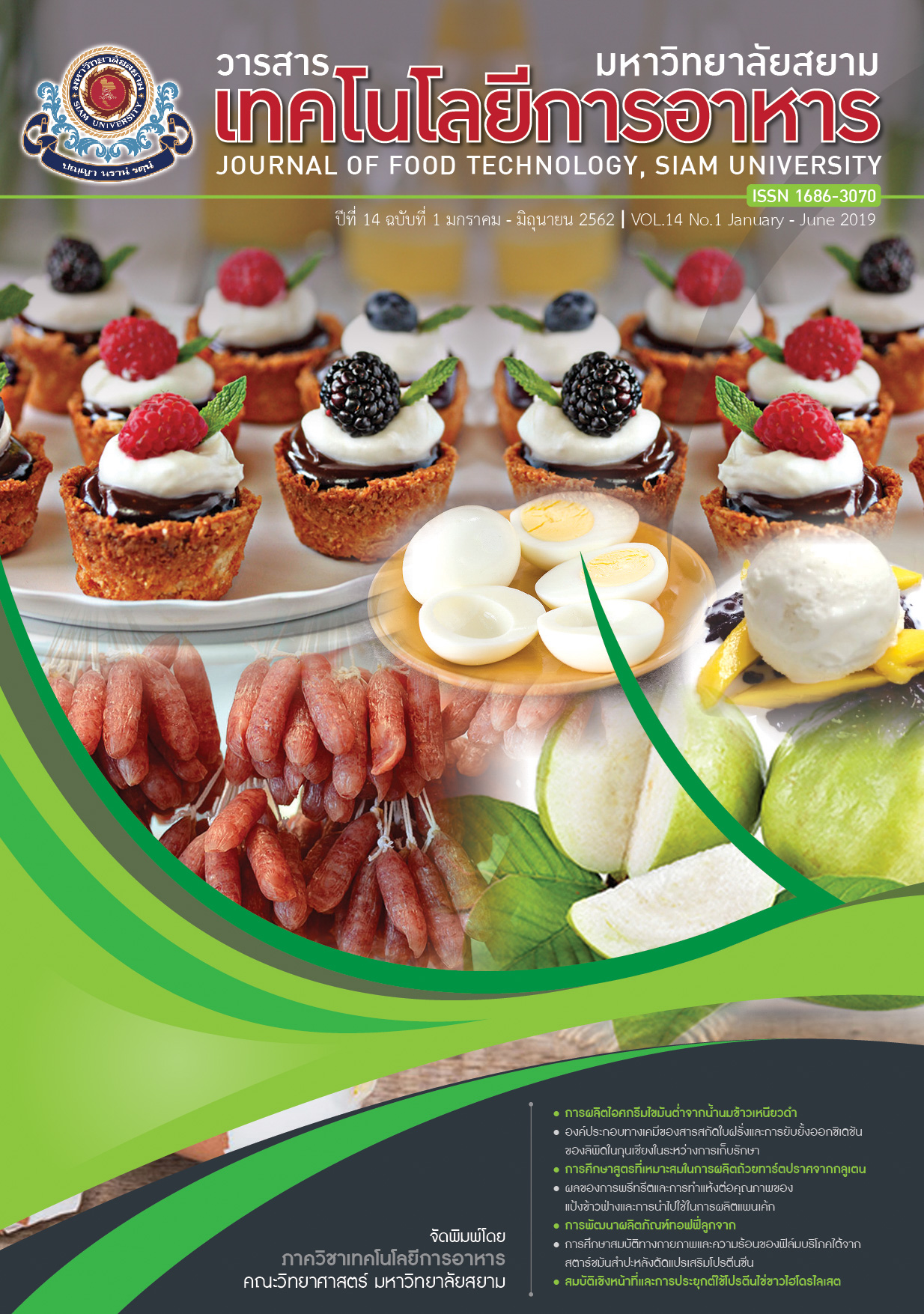การผลิตไอศกรีมไขมันต่ำจากน้ำนมข้าวเหนียวดำ
Main Article Content
บทคัดย่อ
ไอศกรีมเป็นผลิตภัณฑ์นมแช่แข็งที่เป็นที่นิยมในกลุ่มผู้บริโภคอย่างแพร่หลาย อย่างไรก็ตามผู้บริโภคบางคนขาดเอนไซม์แลคเตสในลำไส้หรือแพ้โปรตีนนม ทำให้ไม่สามารถบริโภคผลิตภัณฑ์อาหารที่มีส่วนประกอบของนมได้ วัตถุประสงค์ของการวิจัยเพื่อพัฒนาผลิตภัณฑ์ไอศกรีมเพื่อสุขภาพที่ผู้บริโภคที่มีอาการแพ้นมวัวสามารถรับประทานได้ ศึกษาสูตรที่เหมาะสมในการผลิตไอศกรีมจากน้ำนมข้าวไรซ์เบอรี่ ข้าวเหนียวดำ และข้าวไรซ์เบอรี่ผสมข้าวเหนียวดำ (ร้อยละ 50:50) เปรียบเทียบกับไอศกรีมนม (สูตรควบคุม) วิเคราะห์คุณสมบัติทางกายภาพและประเมินคุณภาพทางประสาทสัมผัส ด้วยวิธีทดสอบความชอบ (Hedonic test) พบว่าสูตรควบคุมมีค่าร้อยละการขึ้นฟูสูงที่สุด รองลงมา คือไอศกรีมสูตรข้าวไรซ์เบอรี่ ไอศกรีมสูตรข้าวเหนียวดำมีคะแนนเฉลี่ยด้านความชอบรวม (7.73±0.88 คะแนน) สูงกว่าสูตรข้าวไรซ์เบอรี่และสูตรผสม ดังนั้นไอศกรีมสูตรข้าวเหนียวดำเป็นสูตรที่ถูกคัดเลือกเพื่อศึกษาการทดแทนวิปปิ้งครีมโดยใช้กล้วยหอมทอง แก่นตะวัน นมถั่วเหลือง และกลูโคสไซรัป พบว่าสูตรที่มีการใช้กล้วยหอมทองทดแทนวิปปิ้งครีมมีคะแนนเฉลี่ยด้านความชอบรวมสูงที่สุด (7.50±0.90 คะแนน) เมื่อนำไปวิเคราะห์ร้อยละการขึ้นฟู ความหนืด และอัตราการละลาย มีค่าเท่ากับ 26.40±0.15 (%), 655.00 ± 3.33 (cP) และ 0.08±0.01 (g/min) ตามลำดับ ปริมาณไขมันในไอศกรีมสูตรกล้วยหอม (ร้อยละ 1.06) มีค่าน้อยกว่าไอศกรีมสูตรวิปปิ้งครีม (ร้อยละ 5.87) ดังนั้นไอศกรีมน้ำนมข้าวลดไขมันจึงเป็นผลิตภัณฑ์อาหารเพื่อสุขภาพที่เหมาะสำหรับผู้บริโภคที่มีอาการแพ้นมวัวได้
Article Details
บทความทุกบทความในวารสารเทคโนโลยีการอาหาร ทั้งในรูปแบบสิ่งพิมพ์ และในระบบออนไลน์ ถือเป็นลิขสิทธิ์ของมหาวิทยาลัยสยาม และได้รับการคุ้มครองตามกฎหมาย
เอกสารอ้างอิง
[2] Jessadapakorn, W., Sangsupawanich, P., Wootipoom, N., Suddeaugrai, O., and Yuenyongviwat, A. (2017). Component-resolved diagnostics in Thai children with cow’s milk and egg allergy. Asian Pacific Journal of Allergy and Immunology. 35: 179-185.
[3] Surojanamethakul, V. (2011). Food allergen. Food Journal (Thailand). 41: 211-216.
[4] Tirasarot, J. and Thanomwong, C. (2015). Production of healthy beverage from “Homnil” rice. KKU Science Journal. 43: 395-402.
[5] Phuenpipob, C. (2013). Developing stability of coconut milk ice-cream by banana flour. RMUTP Research Journal. Special Issue: 19-25.
[6] Duncan, D.B. (1995). Multiple range and multiple F tests. Biometrics. 11: 1–42.
[7] Association of Official Analytical Chemists (AOAC International). (2012). Official methods of analysis (19th edition), Washington, D.C.
[8] Rattanapanone, N. (2014). Milk chemistry. Odeon Store, Bangkok. 206 p.
[9] Boonpitak, W. and Koonchan, U. (2003). Study on the utilization of garcinia for nutrition value-added of yoghurt ice cream. Special Problems. Songkhla Rajabhat University, Thailand.
[10] Srirod, K and Piyajomkhawn K. (2003). Flour Technology. Kasetsart University, Bangkok. 303 p.
[11] Chinabhark, K. (2017). Development of germinated chaiya brown rice yogurt ice cream. KMUTT Research and Development Journal. 40: 17-26.
[12] Yamuangmorn, S and Thebault Prom-u-thai, C. (2016). Variation of anthocyanin content and antioxidant capacity among local Thai purple glutinous rice genotypes. Journal of Agriculture, Faculty of Agriculture Chiang Mai University. 32: 191-199.
[13] Vongpratheep, N. (1997). Studies on factors affecting the yield and quality of soy-curd. Master’s thesis. King Mongkut’s Institute of Technology Ladkrabang, Thailand.
[14] Boonkong, J. and Wongkaew, N. (2010). Production of Soybean Milk Ice Cream. Journal of Food Technology, Siam University. 1: 31-39.
[15] Pojit, T. (2008). The effect of milk proteins and emulsifiers on stability and quality of ice cream mix and ice cream. Master’s thesis. Suranaree University of Technology, Thailand.
[16] Rattanapanone, N. (2006). Food chemistry. Odeon Store, Bangkok. 504 p.
[17] Pornchaloempong, P. and Rattanapanon, N. (2016). Inulin. [Online] Available from https://www.foodnetworksolution.com. [Accessed February, 22, 2018]
[18] Tanjor, S., Judprasong, K. and Puwastien, P. (2010). Inulin and fructo-oligosaccharide for health benefits. Journal of Nutrition Association of Thailand. 45: 2-13.
[19] Bhoyen, K. and Suwonsichon, S. (2013). Effects of blanching and acid treatments on chemical and physical properties of Jerusalem artichoke powder. In Proceedings of 51th Kasetsart University Annual Conference: Agro-Industry, Thailand, February 5-7, 2013, 178-185.


